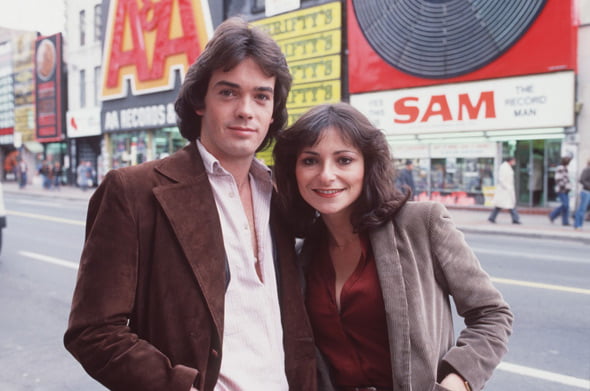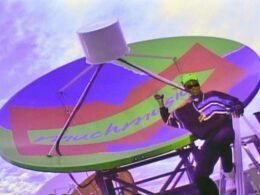Legend has it that when Citytv began its inaugural broadcast on September 28th, 1972, anchor Warner Troyer’s opening salvo was “Welcome to the epileptic circus,” a sly play on the name of what had previously resided at 99 Queen Street East – the building which the ragtag UHF outfit channel 79 now inhabited – a nightclub called Electric Circus. Not just any old nightclub, Electric Circus was brought to Toronto by the notorious Jerry Brandt, club owner, promoter and all around happening Sixties fellow who observed “This city is a hip place. There are some groovy people here. I would like to turn Toronto on.”
Music was in Citytv’s DNA from the very beginning. Co-founder Moses Znaimer adored music and correctly identified its crossover potential in the burgeoning TV universe (Leonard Cohen has perfectly described him as “The CPR of music”). He possessed laidback Montreal sensibilities tempered by a DIY protopunk ethos, at a time when Toronto was in the throes of an almighty Sixties hangover, Rochdale hippie idealism abounded and the ghosts of New York nightclubs loomed large. This fertile breeding ground would just over a decade later give birth to our last great hope in the battle to stop MTV’s soulless encroach into Canada, the mighty MuchMusic.
Back in 1972, Znaimer wanted Citytv Channel 79 to have its own identifiable theme, and so he commissioned king of the jingles Tommy Ambrose to compose “a love song about Toronto.” The result was the romantic, slightly schmaltzy but always endearing “People City,” released as a collectable 45 rpm and used frequently as on-air mood music during the first decade of the station.
Citytv’s earliest crop of musical programming may have lacked the slick style we came to identify with their particular brand of hip, but they sure had heart: Stevedore Steve’s Big Time City Slickers, People Who Sing Together, and Boogie (hosted by R. Paul Godfrey and famously spoofed in SCTV’s “Mel’s Rock Pile”) all served as a prelude to major revolutions coming down the television pipeline.
In 1978, CHUM Limited acquired majority ownership of Citytv, and the die was cast. As well as porting over CHUM talent to City, money and ideas began to flow even faster and more furious than in preceding years. The two stations worked closely together on new initiatives, bearing fruit immediately with FM stereo/TV simulcasts titled Saturday Night at 11.
One year later The New Music arrived like a force of nature and changed everything. In 1979 the world was still two years away from the launch of MTV, and while difficult to imagine at the time there were no in depth shows dedicated to exploring ideas behind music, never mind covering local bands, scenes, alternative culture and obscure New Wave and punk groups. Brainchild of the visionary John Martin, it was “Rolling Stone meets New Music Express, on TV”, with fearless hosts J.D Roberts and Jeanne Beker leading the charge against musical apathy.
In 1982 when Citytv adopted the then-novel concept of broadcasting 24 hours a day, music videos began to play a much larger role, first by plugging gaps in the schedule and then as the basis of several shows tailored to this new and exciting format. City Limits was the first, an all-night music video haven hosted by Christopher Ward and peppered with offbeat skits, B-movie clips and comedic cameos from some Scarborough kid who used to hang around the station claiming to be “the biggest Limitoid in the city”.
The CHUM 30 Countdown premiered in 1983 with host Roger Ashby, while Toronto Rocks debuted in 1984. Rocks enlisted CHUM radio personality John Mahjor, by all accounts one of the most talented and nicest in the industry. He memorably sat in the smallest set in the history of television, a Punch and Judy stage from which he inspired countless kids, garage bands and future rock historians to leg it home from school so as not to miss his essential 4 P.M. broadcasts
By the time the broadcast license for MuchMusic came through in 1984, CHUM/Citytv had harnessed their mutual visual and sonic prowess: The New Music, City Limits, The CHUM 30 Countdown and Toronto Rocks allowed the nimble team who built the house of Much to master their trade and complement innovation with economy, speed and wit. MTV could be challenged, and perhaps even bested. The “Nation’s Music Station” launched on August 31, 1984, with J.D Roberts and Christopher Ward jumping through our screens, while the first proper music video aired was Rush’s “The Enemy Within” fact fans. For a truly gonzo read on the early Wild West days of MuchMusic, check out Bob Segarini’s firsthand account here.
Music meanwhile had also been playing a vital role in Citytv’s most prestigious institution – CityPulse. CityPulse at Six opened with Maynard Ferguson’s punched up, tougher-than-leather cover version of Bill Conti’s “Gonna Fly Now (Theme from Rocky),” while CityPulse Tonight was sound tracked by an all-together grittier and funkier rendition of The Temptation’s “Masterpiece” by Grover Washington Junior, before being replaced by Graham Shaw’s ludicrously shred heavy “Pentatus” for most of the ’80s and ’90s. These cues grabbed you by the scruff, underlining the raw “day in the life of Toronto” street style of the newscasts themselves. During the entertainment portion of the show, most local concerts got a look-in, especially homegrown bands, as did award shows, and even charitable tribute acts.
In 1987 Citytv moved out of the now impossibly crowded 99 Queen Street East building and into the larger canvass of 299 Queen Street West. As MuchMusic exploded across the country, 299 quickly became a cult temple of urban cool in Toronto, as well as a tourist destination for the rest of Canada and later the world. The public were even invited in to witness “the living movie” unfold before them.
Even after successfully launching a sister station dedicated solely to music, Citytv remained committed to creating new musical content. Toronto Rocks had become slightly superfluous in the age of Much’s Pepsi Power Hour, necessitating a flagship replacement. Znaimer instinctively sensed a dance show in the spirit of Boogie would bring even more people to the building, reveling in their accessible new street-front and studio-less environment, and would also solidify the rapport Citytv shared with the local Hip Hop community. In a brilliant homage to their roots, Znaimer christened the show Electric Circus, and in 1988 yet another powerhouse franchise was born.
After moving to Much in the 1990s, Electric Circus also shifted time slots and became a night-time show geared more to the club kids and the Euro dance sound which marked the decade. (It also gained a charting, Mark Dailey sampling theme song – “Hang On, Here We Go” by Jet Fuel. Outdoor events became even more frequent and extravagant, bolstered annually by the New Year’s Eve bash at Nathan Phillips Square which had begun in 1984 and always featured a mix of live music from local bands and Citytv personalities.
Viewers may recall many Citytv shows repurposing pop songs as their themes, as was the case with CityPulse, but also City Line (“I’m Still Standing” by Elton John), City Lights (“Street Beat” by Tom Scott), The New Music (“Papa’s Got a Brand New Pigbag” by Pigbag) and most famously, Fashion Television (“Obsession” by Animotion).
Finally, no round up of Citytv’s musical past would be complete without mention of hedonistic house band the Booze Mothers, who played every Citytv Christmas party and immortalized the 99 Queen Street East HQ with a cheeky cover version of Powder Blue’s “Doin’ It Right (On the Wrong Side of Queen”). Made up of behind the scenes boffins Dave Russell, Bob Haller, Denis Saunders and Michael Heydon, it is unknown whether they are still operational, but their rare as hen’s teeth singles turn up on eBay once in a blue moon.
As the floodgates of digital and specialty channels opened, so did the internet, irreversibly changing the way we consume both music and music videos, and to a much larger extent, television itself. At its best, Citytv’s fascination with and tremendous contribution to music introduced viewers to an eclectic mélange of genres, sounds, cultures and possibilities, truly their core competency and the key to their lasting legacy in people’s city.
Retrontario plumbs the seedy depths of Toronto flea markets, flooded basements, thrift shops and garage sales, mining old VHS and Betamax tapes that less than often contain incredible moments of history that were accidentally recorded but somehow survived the ravages of time. You can find more amazing discoveries at www.retrontario.com.






Lost waaaaay too much of my hearing going to shows at the Horseshoe, Crash and Burn Room, Edge, Larry’s, New Yorker etc. etc.
Teenage Head were always a fun band to drink those incredibly small stubbies to heh ..!